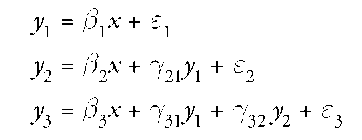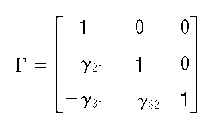A system of equations is recursive rather than simultaneous if there is unidirectional dependency among the endogenous variables such that, for given values of exogenous variables, values for the endogenous variables can be determined sequentially rather than jointly. Due to the ease with which they can often be estimated and the temptation to interpret them in terms of causal chains, recursive systems were the earliest equation systems to be used in empirical work in the social sciences.
In any equation system there will be a number of exogenous variables and as many endogenous variables as there are equations in the system. Exogenous variables are those whose values are determined outside the system and that affect the endogenous variables without being affected by them. Variables that can depend on each other and on the exogenous variables are called "endogenous variables." These are the variables whose values are explained by the equation system. (Some endogenous variables enter with a lag and are called "lagged endogenous variables.") An endogenous variable that appears on the left-hand side of one equation will typically appear on the right-hand side of some or all of the other equations in the system.
A recursive model is a special case of an equation system where the endogenous variables are determined one at a time in sequence. Thus the right-hand side of the equation for the first endogenous variable includes no endogenous variables, only exogenous variables. The right-hand side of the equation for the second endogenous variable includes exogenous variables and only the first endogenous variable. The right-hand side of the equation for the third endogenous variable includes exogenous variables and only the first and second endogenous variables, and so on. Another way to put this is to say that a system is recursive if the solution for the g th endogenous variable involves only the first g equations.
A simple example involving three endogenous variables (y1, y2, and y^) and only one exogenous variable (x) would be the following system—the ss represent the stochastic disturbances (if the system was a purely deterministic, mathematical one, all of the ss would be zero).
From the structure of this system, it is clear that there is a sequential (one-way) rather than a simultaneous (two-way) relationship between the endogenous variables. Thus y1 affects y2, but y2 does not affect y1 either directly or indirectly. Similarly y1 and y2 influence y3 without in turn being influenced by y3. Systems of equations of this kind are called "recursive" or "triangular models." If in addition there is no correlation between the stochastic disturbances, then we refer to the system as "diagonally recursive." Ordinary Least Squares (OLS) is an appropriate estimator for each single equation in a diagonally recursive system because it can be shown that for such a system OLS yields consistent and (asymptotically) efficient estimates. This is because in a diagonally recursive system there is no correlation between the explanatory variables in any one equation and that equation’s stochastic disturbances.
More formally, in matrix notation a system of structural equations may be written as
where y is a vector of the g endogenous variables, x is a vector of the k exogenous variables (these might also include any lagged endogenous variables), s is a vector of the gstochastic disturbances, r is a g X gmatrix of the coefficients on the g endogenous variables, and B is a g X k matrix of the coefficients on the k exogenous variables.
If r is a triangular matrix (that is, it has zeroes in all of the cells above the principal diagonal) we refer to the system as "recursive." This is why recursive models are also called "triangular models."
In the case of the three equations system given above, we would write r as
This is a triangular matrix, indicating that the system is recursive.
Define S to be a matrix of the variances and covariance’s of the stochastic disturbance terms. In the case of the three equations system given above, we would write S as
If r is a triangular matrix and in addition S is a diagonal matrix (so that all the covariance terms are zero), the system is diagonally recursive, and OLS is an appropriate estimator. Now S will be a diagonal matrix only if the disturbances across the different equations are (contemporaneously) uncorrelated—in other words, the disturbance terms are independent of each other. If a system is recursive but not diagonally recursive, in other words if r is a triangular matrix whereas S is not a diagonal matrix, we describe the system as "seemingly unrelated," and the Seemingly Unrelated Regressions (SUR) method of estimation is more appropriate (more efficient) than OLS (Zellner 1962). One reason why the stochastic disturbances might be correlated across equations is if the equations have in common omitted variables, sometimes even variables that by their nature cannot be observed. This is not an unusual situation in the social sciences.
Some equation systems are said to be "block recursive," meaning that the recursive or triangular property applies only to blocks made up of subsets of the equations in the model. If the system can be characterized as block recursive, then the endogenous variables listed in each block of equations may be jointly determined, but the blocks of equations can be ordered such that they (the blocks) form a triangular structure (see Bodkin, Klein, and Marwah 1991 for examples).
Computer packages exist that will take a list of equations and order them in such a way that any recursive structure including recursive blocks are identified. Statistical tests to ascertain whether or not the variance-covariance matrix is diagonal are also available (see Breusch and Pagan 1980 for an example).
The technique of path analysis that features in psychology and other disciplines often utilizes a recursive system, following on the ideas of Sewall Wright (1921). However, while recursive models are easier to interpret than models that are simultaneous, there is no mathematical or statistical reason why path analysis has to be limited to recursive models (see Seneta 2006 and the references cited therein).



